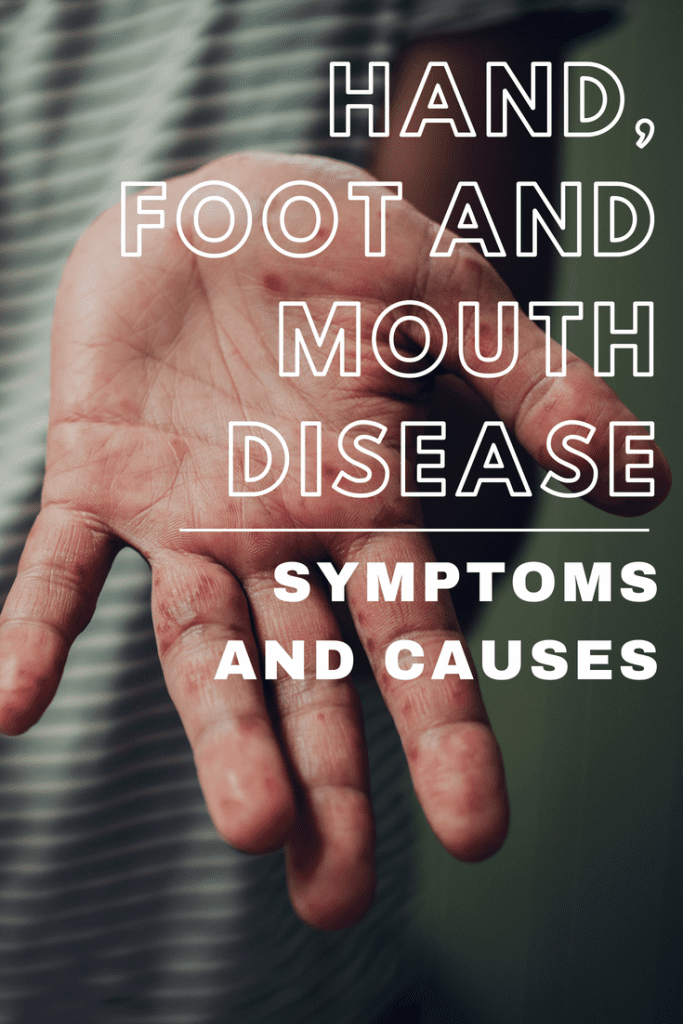Symptoms and Causes of Hand, Foot and Mouth Disease
Hand Foot and Mouth Disease (HFMD) is a very common illness. It can be very scary for parents because it usually affects young children and often starts with a high fever and a rash. It could also be the name – Hand, Foot and Mouth Disease just sounds like something you really want to avoid!

What is Hand, Foot and Mouth?
Hand foot and Mouth disease (HFMD) is a common viral illness. It typically starts with a fever followed by a rash. The rash is most commonly on the chin, mouth and inside the mouth and also on the hands and feet. A rash can also be found in the diaper area. Kids can also experience high fevers and mouth pain that affects their ability to eat and drink.
HFMD usually peaks in summer and early fall and typically affects children who are five years and under. However older children and adults can get it too. One of the frustrating things for parents about HFMD is that it can be caused by different viruses—which means your child could get it again.
What are the symptoms of HFMD?
It usually starts with:
- A fever
- Decreased appetite
- Sore throat
- Tiredness or feeling of being unwell
One or two days after the fever starts, painful sores/small red spots can develop in the mouth that can blister and become painful.
A rash on the palms of the hands and soles of the feet may also develop over one or two days as flat, red spots, sometimes with blisters. It may also appear on the knees, elbows, buttocks or genital area.
Some people, especially young children, may get dehydrated if they are not able to swallow enough liquids because of painful mouth sores. You should seek medical care in these cases.
Not everyone will get all of these symptoms. Some people, especially adults, may become infected and show no symptoms at all, but they can still pass the virus to others.
How is HFMD diagnosed?
Health care providers can usually identify mouth sores caused by hand, foot, and mouth disease by considering:
- Patient age
- Patient symptoms
- Appearance of the rash and mouth sores
Who is most likely to get HFMD?
HFMD usually peaks in summer and early fall and typically affects children who are five years and under. However, older children and adults can get it too.
Is HFMD Contagious?
Yes. The viruses that cause HFMD can be found in an infected person’s:
- Nose and throat secretions (such as saliva, sputum, or nasal mucus)
- Blister fluid
- Feces (poop)
You can get exposed to the viruses that cause HFMD through:
- Close personal contact, such as hugging an infected person
- The air when an infected person coughs or sneezes
- Contact with feces, such as changing diapers of an infected person, then touching your eyes, nose, or mouth before washing your hands
- Contact with contaminated objects and surfaces, like touching a doorknob that has viruses on it, then touching your eyes, mouth, or nose before washing your hands
It is also possible to get infected with the viruses that cause HFMD if you swallow However, this is not very common. This is more likely to happen if the water is not properly treated with chlorine and becomes contaminated with feces from a person who has HFMD.
Generally, a person with HFMD is most contagious during the first week of illness. People can sometimes be contagious for days or weeks after symptoms go away. Some people, especially adults, may become infected and not develop any symptoms, but they can still spread the virus to others.
HFMD is not transmitted to or from pets or other animals.
How to stop the spread of HFMD?
Hand, food and mouth is easily passed on to people by a simple cough or sneeze. To reduce the risk spreading HFMD:
- Maintain good hygiene, such as frequent hand washing and teach your kids (try singing a song while washing hands to teach them the length of time to wash hands)
- Use a tissue to cough or sneeze
- Don’t share towels or household items, such as cutlery
- Wash soiled bedding and clothes in hot water
How soon can children return to school after HFMD?
Those with HFMD should stay home while they are sick. Talk with your healthcare provider if you are not sure when you should return to work or school. The same applies to children returning to daycare.
Is it dangerous to women who are pregnant?
Although there’s normally no risk to the pregnancy or baby, it’s best to avoid close contact with anyone who has hand, foot and mouth disease. If a pregnant woman is infected with HFMD shortly before delivery, there is a chance she can pass the virus to her baby. These babies usually have only mild illness, but in rare cases they may have severe infection.
HFMD is very common and pregnant woman are likely to be exposed at some point in her pregnancy to someone who is infected, especially in the summer and fall. But most pregnant women, like other adults, have immunity (protection) from previous exposures to these viruses. So if she does get infected she will likely not have symptoms or will only have mild illness. Pregnant women without immunity to HFMD viruses have a greater chance of getting infected and having symptoms.
There is no clear evidence that HFMD during pregnancy increases the risk of severe complications like miscarriage, stillbirth, or congenital defects.
How is it treated?
HFMD is a virus so antibiotics won’t help. We use Tylenol or Ibuprofen to help kids deal with the pain. There are also some different mouthwashes that have Benadryl and Maalox/Mylanta in them that can be used to help ease the pain for kids who develop mouth ulcers. Be sure to talk with your pediatrician before treating HFMD.
When can my child go back to school or daycare?
As long as your child is fever free, acting normally and doesn’t have draining blisters, she or he is fine to go back to school or daycare. It may take up to 7 days for all of the blisters to dry up.
What should I notice signs of HFMD in my child?
If your child is showing any symptoms of an hand, foot and mouth, please call Building Blocks Pediatrics at (660) 262-7415.
Other Recent Posts by WMMC:
About Western Missouri Medical Center
Western Missouri Medical Center (WMMC) is a fully-accredited acute care county medical center located in Warrensburg, MO. WMMC prides itself in emergency care, obstetrics, orthopedic and general surgery, family healthcare, internal medicine, outpatient clinics, ambulatory care, rehabilitation services and more. Inpatient services include medical, surgical, intensive, obstetrical, orthopedic, pediatric and skilled nursing care, as well as a wide range of therapeutic and diagnostic outpatient services. This institution is an equal opportunity provider and employer. Learn more at WMMC.com.

